For the purpose of this chapter, the following definitions shall apply unless the context clearly indicates or requires a different meaning.
ABANDONED. A sign shall be deemed ABANDONED if:
(1) It does not display a well-maintained structure or sign face for a consecutive 120-day period;
(2) The owner of the sign cannot be located at the owner's last known address, as reflected on the records of the Department;
(3) A structure designed to support a sign no longer supports the sign for a period of 120 consecutive days; or
(4) Any sign not repaired or maintained properly, after notice, pursuant to the terms of this section.
AMORTIZATION PERIOD. The time between the date of adoption of this chapter and 2-16-2016.
AREA OF SIGN.
(1) The entire area within a circle, triangle, parallelogram or other geometric configuration enclosing the extreme limits of writing, representation, emblem or any figure or similar character, together with any frame or other material or color forming an integral part of the display or used to differentiate the sign from the background against which it is placed.
(2) For purposes of calculating SIGN AREA, the following shall be excluded:
(a) The necessary supports or columns on which the sign is attached;
(b) The portion of a ground mounted or monument sign that is used as the base; and
(c) Any numbers displaying the address of the property.
AWNING SIGN. See CANOPY SIGN.
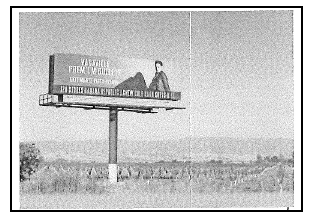
BILLBOARD. A freestanding outdoor sign which advertises an establishment, service, merchandise, use, entertainment, activity product or message which is not conducted, sold, produced, manufactured or furnished upon the parcel or lot in which the sign is located, and additionally shall include those signs as regulated by the state pursuant to Pub. Act 106 of 1972, being M.C.L.A. §§ 252.301 et seq.
CANOPY SIGN. Any sign attached to or constructed on a canopy. A CANOPY is a permanent roof-like shelter extending from part of or all of a building face.
CHANGEABLE COPY SIGN/READER BOARD. A sign or portion thereof with characters, letters or illustrations that can be changed or rearranged without altering the face or the surface of the sign.
CLEAR VISION AREA. The area bounded by the street property lines of corner lots and a line intersecting the street property lines, 30 feet from their point of intersection.
DEPARTMENT. The Building and Zoning Department of Kochville Township.
DIRECTIONAL SIGN. A sign on private property for the purpose of directing traffic onto or off of the premises. DIRECTIONAL SIGNS do not require a permit.
ELECTRONIC MESSAGE BOARD.
(1) A variable message sign that utilizes computer generated messages or other electronic means of changing copy.
(2) These signs include displays using incandesce nt lamps, LEDs, LCDs or a flipper matrix.

FLAG. A flag shall mean any fabric or bunting containing colors, patterns, or symbols used to signify a government or other entity or organization.
FREESTANDING SIGN A sign supported by one or more uprights, braces, pylons or foundation elements located in or upon the ground and not attached to a building.
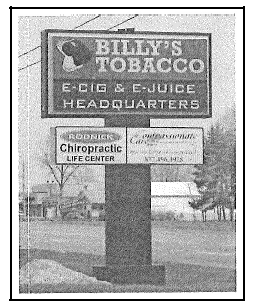
GOVERNMENTAL SIGN. A sign authorized by this municipality, a governmental agency, the state or the federal government for the benefit of the public. The signs may include safety signs, danger signs, trespassing signs, street direction signs, destination signs, hazardous condition signs or signs for traffic control purposes.
GROUND MOUNTED. See MONUMENT SIGN.
INDUSTRIAL CENTER. A coordinated development of a tract of land with two or more separate industrial buildings. The development is planned, designed, constructed and managed on a integrated and coordinated basis with special attention given to on-site vehicular circulation, parking, utility needs, building design, orientation and open space.
INTEGRAL SIGN. Signs made an integral part of the walls of the structure or roof for farm buildings, or when carved into stone, concrete or similar material or made of bronze, aluminum or other permanent type construction.
MARQUEE. Any hood, canopy, awning or permanent construction that projects from a wall of a building, usually above an entrance.
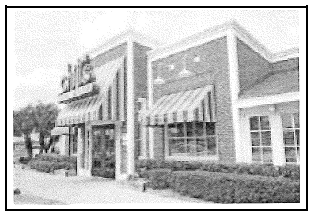
MENU BOARD. A freestanding sign orientated to the drive-through lane for a restaurant that advertise the menu items available from the drive-through window.
MONUMENT SIGN. A freestanding sign where the base of the sign structure is permanently in the ground or integrated into landscaping or other solid structural features.
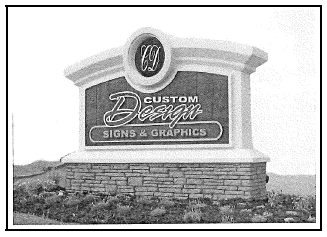
NON-CONFORMING SIGN. Any advertising structure or sign which was lawfully erected and maintained prior to the effective date of this chapter, and any amendments thereto, and which fails to conform to all applicable regulations and restrictions of this chapter, or a sign for which a permit was previously issued that does not comply with the provisions of this chapter.
NON-RESIDENTIAL SIGN. A sign located on a parcel that does not have a dwelling as its principle structure and is located in the CG, AG, R-1, R-1 A, R-2, R-3 districts. Examples of the uses that may be associated with non-residential uses in these districts include but are not limited to subdivisions, schools, religious institutions, public buildings and cemeteries.
OWNER. A person owning the sign and/or the property owner upon which the sign is located.
PARCEL. Contiguous real estate taxed as a single parcel on one side of a public road.
PERMIT. The authorization for the installation of a sign issued by the Department.
PERSON. Any individual or entity, including a firm, partnership, association, corporation, limited liability company, trustee and their legal successors.
PORTABLE SIGN. A sign that is not permanently anchored or secured to a building and not having supports or braces permanently secured in the ground, included, but not limited to, "sandwich" signs and signs mounted on wheels so as to be capable of being pulled by a motor vehicle from one location to another, and which direct attention to the business, profession, or activity conducted on the premises or to a commodity, service, or entertainment that is sold, offered, manufactured, processed, or fabricated on the property. Banners, pennants, pinwheels, ribbons, streamers, strings of light bulbs, inflatables or similar devices intended for a limited period of display shall also be considered a PORTABLE SIGN.
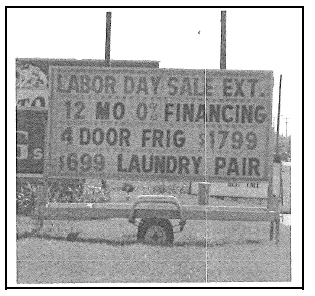
PROJECTING SIGN. A sign affixed to any part of a building or structure that extends beyond the building or structure by more than 36 inches.
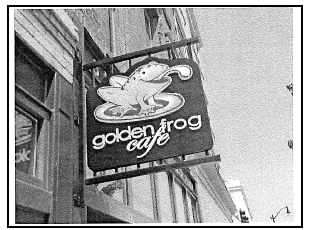
REGIONAL COMMERCIAL CENTER.
(1) A coordinated development of a tract of land with two or more separate commercial buildings with uses classified as regional business uses for zoning purposes.
(2) The development is planned, designed, constructed and managed on a integrated and coordinated basis with special attention given to on-site vehicular circulation, parking, utility needs, building design, orientation and open space. REGIONAL COMMERCIAL CENTERS are greater than 20 acres in site size.
REGIONAL PLAZA/CENTER. Commercial development, usually one store deep. This type of development can include individual buildings on one site or a linear shopping centers with coordinated parking and access. PLAZA/CENTERS are less than 20 acres in size. PLAZA/CENTERS must have a minimum of three businesses.
REPLACING COPY. Any change consisting of re-lettering, replacing or changing the sign face, repainting, cleaning or other similar non-structural changes.
RESIDENTIAL NEIGHBORHOOD IDENTIFICATION SIGN. A sign at the entrance of a residential neighborhood identifying the neighborhood.
ROOF LINE. The highest point on any building where an exterior wall encloses usable floor space. The term ROOF LINE includes the top of any parapet wall; providing, the parapet wall extends around the entire perimeter of the building at the same elevation. The facade of a building is not defined as part of the ROOF LINE.
ROOF SIGN. A sign erected, constructed or maintained upon, or which projects above, the roof line of a building.
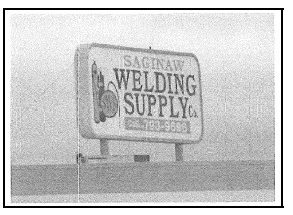
SIGN. A structure which includes the name, identification, image, description, display or illustration which is affixed to, painted or represented directly or indirectly upon a building, structure or parcel of land, and which directs attention to an object, product, place, activity, facility, service, event, attraction, person, institution organization or business, or idea and which is visible from any street, right-of-way, sidewalk, alley, park or other public property. This definition includes the base, frame and support members of the sign. Customary displays of merchandise or objects and material within an enclosed building or placed behind a store window are not SIGNS.
SIGN BOARD OF APPEALS. Is the governing body hearing sign ordinance variance requests.
SIGN LOCATION. Permitted freestanding or monument signs may be located anywhere on the premises, except in clear vision area or within the proposed right-of-way.
SIGN SETBACK. Where it is specified that a sign must be located a minimum or other certain distance from property lines, or public rights-of-way, or proposed public rights-of-way, the distance shall be measured from the portion of the sign structure nearest to the specified line. For the purpose of this measurement, the property lines and public right-of-way lines extend vertically and perpendicularly from the ground to infinity. Unless otherwise noted, all signs shall be set back at the proposed right-of-way line.
SIGN WIDTH. The distance between two sign faces back to back on a freestanding or monument sign shall not exceed six feet measured from the front of each sign face. This applies to parallel and non-parallel sign faces. Signs constructed in a triangular manner shall not exceed six feet at the widest point.
STREET BANNER. Fabric signs, suspended across public streets advertising a public entertainment or event. The Township Board, County Road Commission and/or State Department of Transportation must specially approve the location and contents of each STREET BANNER.
STRUCTURAL ALTERATION.
(1) The modification of a sign and or sign structure that affects size, shape, height or sign location; changes in structural materials; or the addition of electronic elements to a non-electrified sign would be structural alterations.
(2) Exception: STRUCTURAL ALTERATION does not include ordinary maintenance or repair, repainting an existing sign surface, including changes of message or image, exchanging painted and pasted or glued materials on painted wall signs, or exchanging or release and closing clips or other brackets.
TEMPORARY SIGN. Any sign bearing a message which is displayed before, during and after an event, to which the sign relates, and which is scheduled to take place at a specific time and place. A TEMPORARY SIGN includes banners, valances, or advertising display constructed of cloth, canvas and fabric, cardboard, plastic, plywood, wallboard, or other light materials, with or without frames, intended to be displayed for a limited period of time only.
THROUGH LOT. A lot having frontage on two non-intersecting streets.
WALL SIGN. A sign attached to, painted upon, placed against or supported by the exterior surface of any building. WALL SIGNS also include marquees and canopy signs.
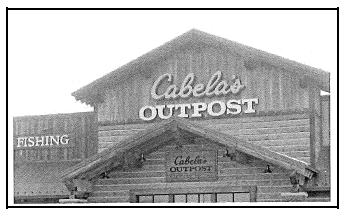
(Ord. 03-05, passed 6-17-2003; Ord. 06-02, passed 4-18-2006; Ord. 10-01, passed 7-27-2010; Ord. 10-003, passed 10-26-2010; Ord. 14-08, passed 8-26-2014; Ord. 16-06, passed 12-19-2016)